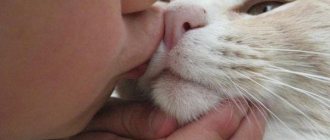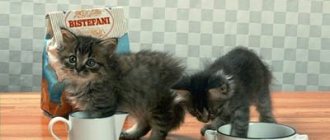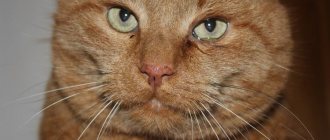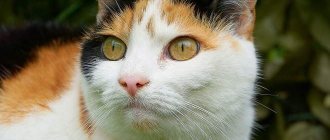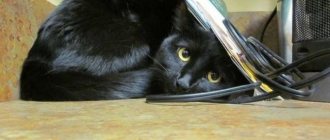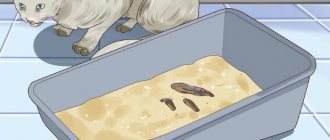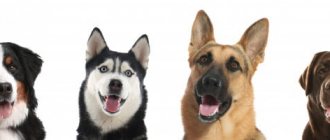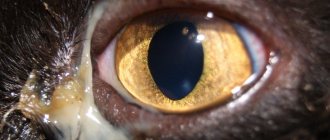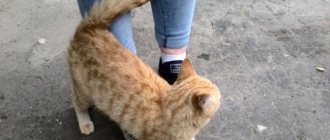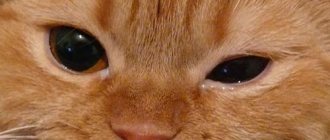Among hundreds of varieties of domestic cats, cat breeds with green eyes are especially popular.
Independent and affectionate, smooth-haired and fluffy, large and miniature breeds are being improved, delighting breeders and bringing happiness to the lucky owners of purrs. In February 2016, the international club of cat lovers “Cat Fancier's Association” took into account 42 new breeds that were bred in different countries. How to find green eyes among all the diversity of the cat kingdom?
© shutterstock
Beautiful names and nicknames for a white cat with blue eyes
Albino cats have no pigment in their bodies.
The name must suit the pet. The nickname is chosen depending on the personal preferences and appearance of the cat. You can name an animal based on your hobbies or in accordance with its color or behavior. The main criteria to follow when choosing a nickname are:
- ease of pronunciation;
- brevity;
- the presence of hissing sounds or the letter Z – pets react to them faster;
- beautiful sound.
Suitable names for blue-eyed pets:
- Diamond;
- Pearl;
- Squirrel;
- Jasmine;
- White;
- Belyanka;
- Sapphire;
- Forget-me-not;
- Winter;
- Pusha.
Caring for white blue-eyed pets
Some owners are afraid to take a white cat into the house because of its brand of fur coat. There are indeed difficulties in caring for, but not so global as to give up on a small white lump. Any coat needs care, but light hair is especially important. After all, even a small spot can turn a luxurious beauty into an ordinary mess.
Some tips for caring for your white pet:
- A white cat will need to be washed more often than darker-colored animals. To take water procedures, you should purchase special white coat care products. If your cat absolutely does not like to be washed, you can buy dry shampoo.
- After taking a bath, the cat should be thoroughly dried with a hairdryer. Dirt sticks to dry wool much less.
- To prevent tangles from forming on the fur, furry animals should be brushed daily.
- If the house is dirty, this will immediately affect the appearance of the pet. In the area where a white cat lives, wet cleaning will have to be done more often.
- If an animal has hearing problems, it should be closely monitored. To avoid trouble, deaf cats are not allowed to leave their homes. If the cat still wants to go outside, you will have to get a harness.
- White cats are more susceptible to ultraviolet rays than their relatives. It is better to protect your pet from frequent exposure to the sun.
- Cats with white fur often suffer from allergies. Therefore, you need to carefully monitor the diet of the blue-eyed blonde.
Since we had a white cat in our house, I can say a few things about caring for her. A cat is a mobile animal; it climbs into all hard-to-reach places and collects dust and dirt there. This is especially noticeable on a white fur coat. Therefore, cleaning had to be done almost every day. The most easily soiled areas of white animals are the muzzle, neck area and groin area. But snow whites are very clean and take excellent care of their appearance. If something happened, we bathed the animal and then dried it with a hairdryer. But, in my opinion, any cat needs to take water treatments from time to time, regardless of color. And we didn’t have any special problems with nutrition and separate care.
White cats with blue eyes have incredible magnetism and attractiveness. The captivating appearance of these beauties is combined with a flexible mind, gentle disposition and friendly character. The blue-eyed blonde will become not only a decoration of the house, but also a reliable, devoted friend to her owner.
Character of gray-blue aristocratic cats
Yes, yes, precisely aristocratic women. The manners, behavior and even the look of a gray cat are usually majestic and calm. These are the real queens (and of course, kings) of the cat world - equanimity, self-confidence and independence. If the owner does not have time to entertain the blue cat, she will perfectly entertain herself. And after that, you won’t have to put your apartment back together piece by piece, since the upbringing of such a cat is impeccable, especially if you spend some time on training at the beginning of its life.
As a rule, such cats are generous, love affection and attention, but easily forgive the neglect shown by the owner. They are smart, like all cats, are not seen in dubious adventures and are devoted to their owner.
Black color in cats
The fur colors of representatives of modern domestic cats are as diverse as the shades of their eyes. A cat's blue-black coat is associated with the presence of eumelanin, a pigment controlled by the dominant B gene. This gene also includes dark colors (brown, chocolate, cinnamon), but in relation to pure black they are recessive.
In order for an animal to get a truly charcoal coat color, in addition to the B gene, a dominant D gene must be present. Both of these genes were found in the oldest representatives of the cat family, and black color is still considered the basic color and one of the oldest. Black cats are found in almost all breeds, and in almost all breeds this color is accepted as standard.
Against the background of a black fur coat, emerald eyes look very impressive
Oriental cats
Cats not only blue, but also some other colors can have green eyes, which sometimes creates very unusual combinations. Let's start with the orientals.
A gray cat, especially a pure color, looks like a sophisticated and elegant animal. These airy, mystical animals seem to be shrouded in a misty haze of fur. The gray kitten seems to fly away like a feather if you blow on it. Not surprisingly, blue is one of the most popular colors. There are also many connoisseurs of marbled or spotted tabby in black and ash tones. Moreover, gray fur color is included in the standards of many breeds.
What does it depend on?
During the embryonic development of the offspring, the formation of its future iris color occurs. The color of a cat's eyes is formed in the womb and depends on the genetic code and hormonal levels in the animal's blood. It is impossible to influence the mechanism for determining color using third-party influence. After conception, melanin is synthesized in the cells of the future organ, which is responsible for the palette of fur and iris. In this case, pigment substances are delivered to the retina and follicles. The intensity of the color of the iris depends on the amount of melanin received - the less, the lighter, for example, a cat with brown eyes received more coloring matter than with golden ones. The process does not end after lambing. Which ones: brown, emerald, light or orange eyes will become clear after a certain time.
Is eye color important to the breed standard?
Kittens' eyes are usually blue-gray and cloudy. When the baby approaches three months of age, the pigment colors the eyes brown, blue, yellow or the coveted green tint. Only at the age of one year do the eyes acquire the most saturated color. Over the years, fading and loss of brightness may occur again.
The palette of eye shades ranges from green to brown. Outbred cats can have eyes of any color in between. In purebreds, eye color is strictly regulated by standards and is often determined by coat color.
Eye color is especially important for show/breed class animals, which may be disqualified during exhibition judging due to the color of the iris not meeting breed standards.
Among all the different colors, emerald green eyes are especially popular among cat lovers. They captivate with their mysterious and enchanting “witchcraft” look; in the dark they sparkle brightly with a yellow light, while blue eyes only slightly sparkle with a reddish color.
Price for Scottish Fold cats
The price category can be different, it usually consists of several points - these are the costs of the breeder for maintaining and raising the animal, and also depends on the shade of the kitten. Typically, individuals that have erect ears are an order of magnitude cheaper than lop-eared ones. Their cost can vary from forty to eighty thousand rubles.
My mother has a Scottish cat, he is many years old and has become a real member of our family. With age, animals become somewhat similar to their owners. We were very lucky to find him one day and would like to say a big thank you to the breeders who never forget about their former pets, who call and come to visit. Scottish fold cats are what a person needs.
When I got a Scottish cat, it became much more fun. These animals are wonderful companions with whom you will never be bored. The cats are simply beautiful, large, with magnificent soft fur and beautiful deep eyes. My pet brightens up long cold evenings, as probably happens to all lonely people. Thanks to everyone who invented this breed and to those who breed and sell these beautiful cats.
My son has been asking for a kitten for a long time. We decided to get a Scot. We wanted something like the one in the Whiskas advertisement, we fell in love with exactly the one we saw on the screen. These animals are simply beautiful. Their character and appearance will amaze anyone who loves affectionate animals.
I would like to tell everyone that if you want to make a real friend, you should pay attention to the Scottish Fold breed of animals
Can there be Scottish cats with green eyes?
It is believed that the eye color of cats of any breed is set by the standard and only in some cases depends on the coat color. Discrepancies from the established color or the appearance of inclusions of various kinds and rims are considered, as a rule, to be defective.
Naturally, various shades of color are also acceptable, but the more they are saturated with a special pigment (that is, the brighter the eyes), the better the quality of the eye color is considered. Most often, cats have three types of eye shade: rich, deep and pale. At the exhibition, during the so-called examination, each judge describes their quality, indicating the color and its shade in a special evaluation sheet. If there is even a slight discrepancy in color from the existing standard, the judge enters this data into the card using a special designation.
Personality characteristics of a gray pet
Many animal lovers believe that fur color provides information about their furry friend's personality, although there is currently no scientific evidence to support this belief. However, it cannot be ruled out that melanin levels may have some influence on temperament. However, personality traits largely depend on the cat's breed and social environment.
Gray animals are often perceived as friendly, cheerful and playful, but your furry pet with this color may have completely different character traits.
What is special about blue eyes
As a rule, in his life a person meets cats that are distinguished by a yellow iris, but one cannot be surprised by the presence of an amber tint or green eyes. Eyes of blue or deep blue color - this phenomenon is rare, although not exceptional. Blue eye color can be considered some distinctive feature of various breeds. When felinologists describe the breed, they indicate that blue eye color is preferred, although other shades are also allowed. It is known that nature is distinguished by its uniqueness, therefore there are individuals with different eye colors. Moreover, there are eyes when one iris consists of two shades that do not mix with each other.
The color of an animal's eyes is related to genetic background. After kittens are born, they open their eyes only after a couple of weeks. At the same time, the eye color is always blue. Experts believe that blue eye color is associated with a lack of melanin, which is responsible for the color of the pigment. When the kitten’s own cells begin to produce melanin, it is already too late, because until that moment the kitten’s body ate what its mother could provide it with.
When a kitten begins to grow and develop, its body begins to produce all the necessary components for life. As a result, the eye color may change and take on the color of its parents. In fact, the body does not always repeat exactly everything that is characteristic of its parents. In connection with this fact, it is worth noting that this is what makes our world so diverse.
In some kittens, the body fully produces coloring pigment, so the color may be more saturated, darker. Some individuals have enough pigment to have normal yellow or greenish eyes.
In kittens with a predominant white tint, who are carriers of the albino gene, this pigment is only enough to make their eyes blue. Often such breeds are born with different eyes. Many people don’t know, and don’t really think about the fact that the reason for everything is a lack of coloring pigment, which is directly related to the level of melanin.
For some reasons, blue eye color indicates various congenital defects or pathologies. In fact, this is not so and the presence of blue eyes is not evidence of the presence of any disease, especially of a genetic nature. In addition to blue eyes, these pets retain all the basic characteristics of cats: acute hearing and vision, a cheerful playful disposition, a desire to hunt, etc.
In any case, when purchasing a white cat (or any other), it doesn’t hurt to have his eyesight and hearing checked. In this case, you need to know that a pet with hearing and vision problems simply will not survive without a person. Therefore, you must always be close to him and not leave him unattended.
When eye color begins to change after some time in life, then special attention should be paid to this fact, since it can be very serious. This may indicate that your pet has begun to develop a serious illness.
Many people attribute magical abilities to cats with blue eyes, are afraid of these cats or expect miracles from them. What the future offspring will be like depends on the genetics of the family, and all we can do is witness the fact of this miracle, protect it and take care of it.
Those owners who love and care for their pets always produce irresistible beauties that evoke surprise and admiration.
Ojos Azules – All about the Cat breed | Cat breed – Ojos Azules
Watch this video on YouTube
Features of temperament and behavior
If you compare the characters of breeds that, according to the norms, are supposed to have a gray color, you will notice some similarities in their features. Gray cats are independent, self-sufficient, and will not constantly demand the attention of their owners. They are distrustful of strangers, at first they behave coldly and unfriendly towards them. Nibelungs can even show aggression towards guests; other breeds are less warlike, but no less wary of strangers.
At the same time, all breeds are affectionate with “their own”, sociable, although some of them “listen” more than “talk”, but they make contact - and sit next to them, and pose for photos, and are clearly interested in their person. But these are not the most tactile cats, especially Chartreuse cats. They don’t like to sit in your arms or try to pester them with affection when they don’t want to, but they are patient, especially with children, and won’t scratch. And the Russian Blue does not release its claws at all when interacting with a person.
Gray cats are calm, balanced, delicate, and accommodating. Korat, for example, is very loyal even to dogs if they do not try to attack him. All breeds readily interact with children; even the Russian Blue forgets its manners and happily runs around with them. Chartreuse is too lazy for outdoor games, but will tolerate it if children begin to carry it in their arms. But the playful Korat will actively participate in all the pranks.
Interpretations of different dream books
Absolutely all sources believe that dreams with a black cat have meaning and consequences. There are different interpretations, both categorically calling them a bad omen, and those considering such a dream to be a good omen.
The cat signifies troubles from the outside, black magic, the struggle between the dark and light sides of the sleeper’s personality.
Dream book of the 21st century
The animal portends conflict:
- Bitten or scratched - a person from the immediate environment is offended.
- A cat walks across the road - to a meeting with an enemy or a deceiver.
- Petting a black cat means experiencing distrust and emotional distress.
- To catch her is to find out gossip about yourself.
Enigma
Harbinger of negativity:
- The cat dreams of a quarrel or fight.
- If you cross the road, you will meet a woman who wants evil.
- Killing a kitten means missed opportunities, killing an adult cat means triumph over an opponent.
- A dirty and sick animal in a dream means illness of a person from your immediate environment.
- The mating games of “March” cats are the problems of the spouses.
Miller
A black animal in a dream is a negative sign, a symbol of chaos in life:
- If it attacks and tries to bite, the enemies will strive to cause harm, which can be avoided by killing the cat.
- A dirty stray cat means bad news from relatives or a friend’s illness. Meowing - symbolizes lying friends who want evil.
- The cat scratched - the plans of the enemies threaten to come true.
Wangi
A black cat is the personification of selfishness, pride and conflicts:
- Scratched - a person suffers from groundless jealousy.
- If you catch a mouse, you will have to witness a conflict.
- You dream of a huge aggressive cat - a strong enemy seeks to harm.
- Catching an animal means meeting a proud and narcissistic person.
Freud
The cat is a symbol of sensuality:
Feeding him means seeking intimacy with young partners. To caress is to desire sexual intercourse. The animal pets itself - the personality attracts attention. Beating or killing a cat is a tendency towards sadism. If he scratches or bites, the sleeper is prone to masochism.
Black color allowed
American Bobtail
If the previous breed is called the Bombay Black, then among the short-tailed American females there may also be black individuals. This fluffy dog is susceptible to training and has high intelligence. If your pet is accustomed to wearing a harness, he will be happy to take walks with his owner in the park.
The color includes various shades of black and tabby - black stripes on a fawn or gray background.
Siberian cat
These majestic creatures are covered with thick hair with a water-repellent effect, have a double and dense undercoat and “pants” on the hind legs. They are excellent hunters of mice and rats. They are easy to care for and tolerate almost any weather conditions well.
Oriental cat
The elegant blue-black cat with charcoal pads is the most “refined” among its relatives. There are a total of 42 types of colors in individuals of this breed. Affectionate and friendly pets are not pretentious, but they should be protected from the cold.
Devon Rex
Large shining eyes combined with “elven” ears are mesmerizing. The neck is thin and the head is slightly flattened. The beauty walks on high legs and proudly wears her long tail. The animal is energetic and affectionate, and is also well adapted to life in the city.
Turkish Angora
The long-haired cutie was brought from Byzantium. Fluffies can be painted in different colors, including pure black, with white splashes and other options.
Norwegian forest
The fur of representatives of this breed is smooth and thick. Sideburns can be seen on the cheekbones. In winter, a fluffy chic collar “falls” over the shoulders and neck. The ears are pointed with tassels, the tail is long, the legs are high with heavy pads. The color is varied, but always the same color.
Other breeds of gray cats
There are also breeds for which gray coat color is one of the acceptable color options. Among them there are spotted and solid, smoky or lilac, dark gray or light, silver cats.
Egyptian Mau
The Egyptian Mau breed is allowed only three colors, two of which are gray. Silver cats have a light gray, steel-colored fur, while smoky cats have silver or gray fur. In both cases, the color is not supposed to be solid; there should be black or dark stripes and spots. The silver coloring is accompanied by black edging around the mouth and eyes.
British
There are about 200 color varieties included in the British breed standard, most of them being variations of the gray color.
The fur of purebred British dogs is uniformly colored. Spots or streaks of any color do not meet the standard.
Scottish
The gray color of Scottish cats is not the only acceptable color for the breed, but it is the most popular. A fat gray cat with a touching face and curled ears appears much more often than other Scots in photographs on the Internet.
The cat's coat should have an even color. In addition to the blue tint, Scots can be silver, marbled, or chinchilla.
Persian
The long hair of the Persian breed comes in black, red, white, cream, and others. But the uniform gray color is one of the most prestigious.
In combination with long hair, it makes the cat more decorative, and the gray fluffy kitten of this breed looks like a delicate cloud of fog. The most valuable representatives of the breed are the lilac, blue marble, and bluish-smoky cat.
Turkish Angora
Initially, according to the breed standard, it was a white cat with blue eyes. Now the scope has expanded - the Turkish Angora can be red, black, and also have a gray, blue, smoky color.
But lavender color is already considered a defect. The paw pads and nose of gray individuals should have a bluish tint. Multi-colored eyes are also a characteristic of the breed.
Australian smoke
The coat of the Australian smoky can be painted in different colors, including a blue palette.
Regardless of the color, the color combines three shades: the lightest one covers most of the body, “on top” of it, the darker ones, are spots. The third shade creates a haze that softens the outline of the spots. It seems that the cat is painted in several layers.
Asian smoky
Solid blue is in the list of acceptable colors for the Asian Smoke. Due to the lighter tone of the undercoat, moiré stains appear on the fur when the animal moves.
Siberian
Siberians have many colors. Among them there are blue individuals of different shades - from dark to the lightest. A sign of the breed is the absence of rusty areas. The nose and paw pads are gray.
Siberian cats can also be blue silver tabby or blue smoky.
Maine Coon
This large cat is also solid blue, with a coat color that is more of an ash color with a blue tint.
Coons also have a blue smoke color and a blue-cream tortoiseshell solid color, in which the gray coat is combined with spots of a light pink shade.
Ocicat
There are more than 12 colors of the Ocicat breed. Among them there is a blue one with light blue and yellow-blue spots. There may also be silver spots on a blue or purple background. The paw pads are light blue or pinkish, and the nose is pink with a blue edge.
Bobtails
Short-tailed bobtail cats (Kurilian, Japanese, American, Thai, Karelian) also have blue coloring in combination with tabby. Spots or stripes of a darker shade.
Cat breeds with different eyes
So, there is no blue-eyed gene, no deafness gene, no different-eyed gene. Why does the Internet persistently offer some cat breeds as “different-eyed”? These are breeds where the snow-white color is:
- is the only valid one: kao-mani;
- very common: Turkish Angora;
- combined with colored spots: Turkish van.
Angora cat with different eyes
Turkish Van cat with heterochromia
Different eyes are often found in cat breeds for which white color is only an acceptable variety, and not the main breed characteristic. Breeders have a theory that to produce kittens with heterochromia, you need to cross white animals with bicolors.
Outbred black and white cat with different eyes
Bicolor color in Russian - two-color. Such animals are also called piebald: white spots alternate with colored areas. If there are a lot of white spots, then the cat may look completely white (a speck of color can be located on the tail or on the head). This white color is caused not by the W gene, but by the white piebald spotting gene - S (spot). The S gene also disrupts the migration of melanocytes to the fur and sometimes to the eyes, but does not cause deafness. Since the spots are characterized by asymmetry, it is not surprising if one eye is colored and the other is not.
It is the spotting gene S that is responsible for the color and heterochromia of the eyes in Turkish Vans, while in Kao Mani and Angora it is the dominant gene for white color W.
A Turkish Van cat with different eyes. The piebald S gene is responsible for color
There is another pattern: if a matched couple has a kitten (or several) with different eyes in their litter, then there is a high probability that in the next litters from these parents it will be possible to consistently produce kittens with heterochromia.
Thus, eyes of different colors can be found in cats of any breed, if white or spotted color is acceptable according to the standards - Cornish Rex, Sphynx, Maine Coon, Persian and exotic cats, British cats and many others.
White Cornish Rex with heterochromia
You should not discount ordinary mongrel cats - mestizos, in which heterochromia is also common. It must be said that a kitten with different eyes sharply increases the chances of finding a home - many are ready to take such an unusual pet, even if it is of “noble” blood. It is believed that cats with different eyes bring good luck to the owner and have strong magical powers. And even if you are far from esoteric, it is impossible to deny that cats with heterochromia look very impressive and mysterious.
Mongrel cat with different eyes
One of my friends even found a “bride” for his mongrel cat in the hope of getting an odd-eyed kitten. Unfortunately, the white Dobby (one eye is yellow, the other blue) and the white blue-eyed cat gave birth to kittens with the same yellow or blue eyes. Two of them were cream-colored, two were white - and both white kittens turned out to be deaf.
Mongrel cat with different eyes
Features of chocolate color
The black color gene, or rather its mutation, is responsible for the appearance of chocolate color. As a result of the reduction in the amount of eumelanin granules, the black color gradually changes from chocolate or chestnut to cinnamon.
Chocolate is recessive to black, and cinnamon is recessive to chocolate.
Black cats often have a red tint to their fur, which makes them appear brownish in the sun.
Reference. Eumelanin granules are spherical in shape, absorb 98% of sunlight and produce black pigmentation.
The chocolate, chestnut and brown coats are a rich chestnut brown. The iris is green, copper or orange. The nose is brown, the paw pads are brown or cinnamon.
How to choose a kitten
You need to choose older kids. The main rule here is that the older, the better.
The final breed characteristics of kittens are formed by the age of one year, but already at three months you can understand who the baby will grow up to be.
Kittens should have pale green eyes. Soon they should turn emerald. White spots are not acceptable.
The weight of a 3-month-old kitten is about 2 kg. You should not adopt a kitten with a crooked tail. Ideally, the tail should be flexible.
The bouncy and curious Russian Blue loves to play everywhere and with everyone.
When choosing a kitten, meet the baby's parents. The way they look is the way your Russian Blue cat will look.
Kittens of this breed inherit their parental characteristics well.
There are disadvantages that can be ignored.
The slight striping on the tail of kittens will disappear over time. The protruding long awn will soon come out on its own.
These rare long needles can even be plucked out. Ear tassels are also easy to remove.
The Russian Blue has a highly developed hunting instinct. She catches flies, mosquitoes and butterflies, and can watch for mice for hours
The connection between green eyes and coat color
Eye color from blue-green to the delicate shade of young gooseberry can be found in cats of different breeds of the following colors:
- black options - solid, tabby, particolor;
- blue, silver, lilac;
- chocolate and lighter cinnamon;
- faun;
- golden (including red);
- smoky;
- tortoiseshell (tabby, particolor, fawn, smoky);
Black cats with emerald eyes look very sophisticated and elegant in photographs. They bring positive energy and prosperity to the house, and good luck to the owner.
Green-eyed, red-colored animals were revered in ancient times. Red-haired green-eyed dogs always look bright and bring vitality and positive energy to their owners. Red color in combination with green eyes is a sign of chosenness.
The ancient Assyrians considered a white cat with green eyes to be a cult animal, bringing good news, reconciliation of enemies, and success in business. The color of purity and innocence. Green-eyed whites are charming, mysterious, and affectionate.
Among white cats, the Turkish Angora with its long and silky hair is particularly mysterious. This breed has green or blue eyes. But an amazing feature is often encountered: with age, one eye acquires a green tint, the other - blue. White cats, having different eyes, can be unpredictable in their habits and actions. A mystery cat that quickly changes anger to mercy.
How do kittens' eyes change?
The final eye color in cats is established by the age of 2 years. The process of changing the color of the iris is called reblooming. Most often it begins in the 4th week of a kitten’s life. In this case, the usual blue tint of the eyes is diluted with splashes of a different color. Gradually, these inclusions grow and the animal’s eyes acquire a constant shade.
Sometimes in white cats you can observe a difference in eye color. For example, one of them is green and the other is blue. This phenomenon is called heterochromia. Most often it is found among Turkish Vans, in rare cases among representatives of the British, Scottish or Persian species. Cats' eyes can not only change color, but also fade with age. At the same time, once bright shades turn into dull ones.
So, if you have a preference for cats with a certain eye color, adopt a kitten at 4 months of age. At this time, it is already possible to determine what color of the pet’s iris will be. Later it may acquire greater depth and richness, but its basic tonality will remain unchanged. It is worth noting that eye color is not a feature of a particular breed. This is a purely genetic criterion, where blue color is a recessive trait.
Color
Photo of a cat of the Korat breed.
The monochromatic color of gray, according to the terminology adopted by felinologists, is called blue. This color of kittens is a symbol of the higher unearthly world, therefore blue cats are recognized as conductors of spirituality. These animals provide healing from illnesses and protection from dangers, and bring prosperity to the family hearth. From a genetic point of view, the presence of a blue shade is determined by a combination of the black color gene B and the recessive allele d. It turns out that gray color is formed as a result of lightening black. In this case, various combinations of genes are possible, leading to a variety of colors: plain, with stripes, silver. The type of color is determined by the depth of charcoal coloring of individual hairs, as well as the alternation of white and black stripes.
Basic colors of Scottish Fold cats
The animal may have a gray color, which is obtained by diluting the black color and diluting it with a suppressive gene. Also, white color of animals may occur; it is considered an absence of color due to the suppression of other genes. Cats can be simply white or albino; this occurs due to the action of different genes responsible for establishing color.
The colors come in the following colors:
- Plain black;
- Chocolate;
- Blue;
- Cream;
- Red;
- Cinnamon;
- Lilac;
- Chinchillas;
- Tortoiseshells;
- Tubby and others.
Peculiarities
First of all, you need to understand that a white cat owes its luxurious color to albinism genes. An albino kitten basically has no color; the albinism gene is responsible for the lack of pigmentation. If you have a real albino in front of you, then the iris of his eyes will be reddish. Such representatives of the cat kingdom are very rare. But blue-eyed albinos are more common. To get a white kitten, you need to breed a cat with the white gene with a male of any color. If you bring together a cat and a female cat, both of which have this gene in their kits, then the color of the kittens is indeterminable, it can be anything. As a rule, cats with this genotype have brightly colored eyes.
The gene responsible for piebaldity produces solid white spots, but outwardly the animal looks completely snow-white. It happens that the spots do not adjoin one another, then the animal turns out to be spotted. Eyes can be different colors. People who own white cats often associate them with characteristics that are scientifically inexplicable. For example:
- a white cat crossing your path brings good luck, success, winning;
- a domestic cat of this color should bring prosperity and financial prosperity to its owners, but a strange cat entering your house will most likely bring material loss;
- snow-white cats cannot be offended, otherwise they will attract misfortune;
- white cats are even credited with the ability to increase a woman’s chance of conceiving a child if she often strokes her pet’s light fur;
- When placing kittens, it is recommended to give cats to men and cats to women.
Folk signs
Gray cats are reputedly associated with secrets and riddles. In the folklore of different nations, there are beliefs associated with these pets:
- Meeting an animal in a silver coat on the way is good luck. To consolidate success, you should say “Gray cat - happy path.”
- A blue pet that comes into the house on its own brings harmony, comfort, and protection from evil forces.
- A gray cat as a pet prevents discord in the family.
- Before an important event, you need to pet the gray cat so that everything goes smoothly.
- The gray cat is the brownie's best friend, the protector of the hearth.
- A pet with blue fur attracts financial success to its owner.
- To drive away a gray cat means to get yourself into trouble.
Black cat breeds
How beautiful and graceful the silhouette of a pitch-black animal looks, carefully sneaking in the twilight of the night. It is almost invisible, barely audible, and in the light of the moon suddenly and shyly peeking out from behind a cloud, it is dazzlingly beautiful.
Since the creation of the world, black cats have had an undoubted advantage due to their color.
The ability to disappear into the night gave them superiority in the hunt, the same quality made them practically invisible when they themselves were in the role of the victim.
There has never been an unambiguous attitude towards black tailed animals. For the Egyptians and Phoenicians these were deities. They lived in temples under royal conditions and were considered possessors of magical and healing powers.
In Europe and England, “black demons” during the Inquisition, on the contrary, were burned at the stake along with the so-called witches. Praise the Lord if there was even a small bright spot on the resin coat of the pussy! This could have saved her from a painful death.
That is why European black cats practically disappeared as a species, leaving only motley, black and white animals.
In Ancient Rus', beauties the color of the night were also not held in high esteem. They, of course, were not burned alive, but were considered the spawn of demons. If a black cat crossed the road, it was considered a bad sign (however, even now many people think the same way).
For reference:
The science of genetics states that black and tabby (when the main background is lined with striped patterns) are the basic colors of all known breeds of domestic purrs. The oldest gene, B, is responsible for the charcoal shade. It is this gene that regulates eumelanin, a pigment in the coat. In addition to the dominant color, there are recessive, that is, secondary: chocolate and cinnamon (cinnamon).
Bombay black
The Bombay breed actually has nothing to do with the glorious Indian city. Black Bombay pussy is a purebred "American". Its creator was felinologist Nicky Horner (USA) in the mid-20th century. She set a goal for herself - to breed a cat identical in appearance to a panther.
Two breeds were taken as a basis: the Burmese and the American Shorthair, and after 4 years the newly created Bombay was officially registered as a new cat species. The characteristic of the standard is a shiny, smooth, dazzling black coat and paw pads and nose of the same color.
There should be no other color from the word “at all”! At birth, babies may have a light spot, but it disappears as they grow. The color of the iris changes twice: if at birth the eyes are blue, then by the age of one year they are gray, and as they grow older they become bright, the color of golden amber.
American Bobtail
Short-tailed cats of American selection. Quite large representatives of the cat breed, their weight varies from 4 to 7 kg.
https://www.youtube.com/watch?v=_sLWMCfdS9w
A characteristic feature of the breed is considered to be high intelligence and receptivity to training. American Bobtails easily learn to wear a harness and enjoy taking long walks with their owners.
They have a wide wedge-shaped head, almond-shaped eyes, short legs, a double layer of fur, and a small (up to 2.5 cm) movable tail, like a hare or rabbit.
American Bobtails come in a variety of color types, including:
- shades of black (charcoal black, black-brown, black-ash);
- tabby (the classic type is more common - black stripes on a gray-silver, fawn background).
Oriental cat
In 1958, the “brown oriental” cat breed was registered in the UK, later renamed the “Havanese”. As a result of further selection, feminologists received a lighter, graceful subspecies called foreign shorthair. Subsequently, the subspecies standard extended to all oriental cats.
Black Oriental gets its name from its similarity in color to that of exotic black ebony. Blue-black cats with black paw pads look very elegant and are recognized as one of the most “refined” among their relatives.
Popular breeds of chocolate cats with photos and names
There are not so many breeds of cats of true chocolate color. We have made a selection of breeds that, according to the standard, have a luxurious brown, cinnamon and chocolate coat.
Havana brown
Havana Brown is a rare breed of beautiful cats. The animals came to Great Britain from Siam in the 19th century. at the same time as Siamese cats. However, the British Siamese Cat Club has banned the breeding of other types of Siamese except blue-eyed Siamese cats. As a result, the Havana Brown population declined catastrophically, and the breed was on the verge of extinction.
Fortunately, in the 50s. XX century breeders began studying the genetics of cat colors and began conducting experiments as part of this program. The result of such research was the appearance of chocolate-colored muskies.
The Havana Brown's coat color has been compared to chestnut, hazelnut or mahogany. The breed received its name in honor of Havanese cigars, the color of which is similar to the color of these cats.
The coat color goes harmoniously with green eyes. The color of the iris varies from the lightest to the darkest shade. The Havana Brown's glossy, soft brown coat and emerald eyes make it a popular breed.
Another distinctive feature of the breed is its rounded, light-bulb-shaped muzzle. Depressions are visible in the area of the vibrissae. The chin looks heavy and massive. Large oval eyes set low. Large ears with rounded tips are tilted. Despite their compact size, the skeleton of these cats is massive, which is why males weigh 3.5-6 kg, females - 3-4 kg. Havana Browns give the impression of a sophisticated person, despite their well-developed muscles, and are distinguished by their gracefulness.
By nature, chocolate-colored Havana Brown cats are calm and balanced, affectionate and sociable. They need human attention and do not like to sit alone.
York chocolate
The Yorkie Chocolate cat was created by chance, the result of a mating between a farm cat with black and white spots and a long-haired black cat. Chocolate-colored kittens of the Yorkie cat breed with chocolate fur were born. Breeding was done by Janet Chifari from New York. Hence the name of the breed, which is popular only in its homeland. Felinologists admit that Persian and Siamese cats also participated in breeding.
The Yorkie beauty is distinguished by its large size, strong bones and developed muscles. The hind limbs are longer than the forelimbs. The semi-long coat frames the neck in the form of a “collar”. The structure of the coat is soft and silky. The coat is glossy and glistens in the sun. The undercoat is semi-long and dense. On the limbs and tail the hair is thicker and longer. Tufts of hair stick out between the toes, and the inner surface of the ears is pubescent.
Acceptable colors are chocolate and lilac solid, or with an admixture of white.
York chocolate is suitable for active people and families with children. Purr gets along with other cats, is distinguished by hunting skills, and loves to monitor the movements of people around the house. In addition, representatives of this breed love to swim. Owners of Yorkie beauties compare them to dogs. Animals are in constant motion, amenable to training, and love to play with interactive toys. Life with such a cat will not be boring!
Short tail
It is noteworthy that the presence of a tail in a “rudimentary” state or its complete absence in cats is a sign of “noble” origin (in contrast to the same domestic dogs, whose tails are docked deliberately - to fit the animals to the standards of a particular breed). It is worth noting that there are only a few types of short-tailed/“tailless” cat breeds, which include:
Kurilian Bobtail
a short curved tail approximately 5-9 cm long, resembling a fluffy pom-pom and characterized by mobility, a relatively small body with strong bones, developed muscles and limbs of medium length, a triangle-shaped head with medium-sized eyes corresponding to the color, short-haired or semi-long-haired, but in in any case, with a fluffy collar on the neck and chest.
more details
American Bobtail
a short and flexible tail from 2.5 to 8 cm long (it can be straight, curved, and slightly curled at the end), a body of medium length with an athletic build and strong paws proportional to it, a round muzzle with strong jaws and ears, an internal the surface of which is covered with long fluffy hairs, short or long hair, but always thick and slightly harsh.
more details
Japanese Bobtail
a short tail no more than 12 cm long (straight, curled, curved or in the form of a pompom), a long and lean body with a flat back and slender legs (the hind legs are noticeably longer than the front ones), a muzzle with large oval-shaped eyes and large, wide-set ears, soft and silky coat of medium length.
more details
Mekong Bobtail
a short and broken tail with a length of at least three vertebrae (but no more than a quarter of the length of the body itself), a strong and muscular body of medium size with long legs, a wedge-shaped head with medium-sized ears (with rounded tips) and slightly slanted eyes, always bright blue , short silky coat with minimal undercoat.
Karelian Bobtail
a short tail 4-13 cm long (can be either kinked or almost straight), a strong body with an even posture and proportional paws, a narrow head with a small strong chin and rather large ears with tiny “tassels”, short or long hair ( necessarily dense).
Kurilian Bobtail
“no, not a relative”
short tail 3-8 cm long (with pronounced kinks), strong build with a slightly arched back and powerful paws, large trapezoidal head with a powerful chin and proportional ears, short or long hair (very soft to the touch).
more details
Pixiebob
short straight (but possible kinks) tail about 5 cm long, large and muscular body build with powerful bones and a clearly defined arch on the back, large pear-shaped head, tightly knit and strong paws (the hind legs are noticeably longer than the front ones), short or moderately long hair with different color options, but always with small or medium spots throughout the body.
more details
Manx cat
they may either have no tail completely, or have a small “stump” hidden under the fur, or generally have a tail of normal length, a medium-sized round body with a round head, powerful limbs with well-developed muscles (the front ones are noticeably shorter than the back ones), round eyes with a slight slant, short and thick coat, like “plush”.
more details
Cymric cat
Kymrik
tailless breed (but there can be either a “stump” or even a full tail), a tightly built physique with a wide chest and an arched back, short front and long hind limbs (with heavy shins), thick hair of medium length.
more details
Green eyes – breed standard
The standard provides for green eye color in the following breeds:
- oriental;
- Russian blue;
- Karelian bobtail.
Oriental
The origin of this breed is lost in the mists of time, shrouded in myths and legends. The first mention of these amazing cats with a melodious voice is found in ancient Thai writings.
Friendly and sociable, who cannot stand loneliness, sociable, active and energetic, Orientals have an excellent character and unusual appearance. Slender and refined, but strong physique, developed muscles, long head, body and tail, shiny silky coat with a fine structure. The muzzle is wedge-shaped. The ears are wide at the base and tapered to the tips.
An outstanding feature of Oriental cats is their almond-shaped eyes, set at a large angle in relation to the nose. The only acceptable color of the iris is green: from saturated to moderate.
Russian blue
This green-eyed cat breed was developed in Russia under Catherine II. The name “Russian Blue” was officially assigned in 1939; before that, the breed was called Arkhangelsk.
The plush, thick, soft coat of a gray-blue hue, the lilac hue of the paw pads and the sophisticated, flexible body with impeccable proportions form the stunning appearance of Russian Blue cats. They resemble the British, but have a more graceful build.
Their aristocratic manners, piercing gaze and rich bright green color of expressive eyes, large and widely set, give them a special charm.
Distrustful with strangers, affectionate, understanding and slightly shy with their owners, calm and balanced, yearning alone, they prefer to sleep during the day, and at night they show increased activity.
Noble, spectacular, sophisticated cats have excellent immunity and live on average 14-16 years.
Karelian Bobtail
Resembling wild animals in its appearance, this breed of cat was bred in St. Petersburg at the end of the 20th century.
A short tail similar to a fluffy pom-pom, the inherent grace of wild cats, thick hair and expressive green or blue eyes - this is what this unusual breed looks like, originating from Norwegian forest cats.
Unpretentiousness in care, independence and self-sufficiency, taciturnity, calm attitude towards the absence of the owners at home make this breed ideal for people who are often absent from home.
Summarizing
Black cats have always attracted the attention of people; they were surrounded by an aura of mystery and even witchcraft. Superstitious people still believe that a black cat crossing the road brings bad luck.
It has long been proven that this sign has no basis, so lovers of coal pets, free from prejudice, dote on them.
Despite the fact that such cats “get in the way” of their owners every day, this only brings them happiness
Bright green eyes are a real decoration of a black cat, because there are no other shades in its color. This spectacular combination is present in many breeds, and a person who wants to buy a black green-eyed kitten can be guided by his preferences in the pet’s character.
